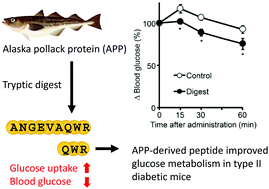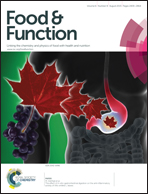A novel Alaska pollack-derived peptide, which increases glucose uptake in skeletal muscle cells, lowers the blood glucose level in diabetic mice
Abstract
We found that the tryptic digest of Alaska pollack protein exhibits a glucose-lowering effect in KK-Ay mice, a type II diabetic model. We then searched for glucose-lowering peptides in the digest. Ala-Asn-Gly-Glu-Val-Ala-Gln-Trp-Arg (ANGEVAQWR) was identified from a peak of the HPLC fraction selected based on the glucose-lowering activity in an insulin resistance test using ddY mice. ANGEVAQWR (3 mg kg−1) decreased the blood glucose level after intraperitoneal administration. Among its fragment peptides, the C-terminal tripeptide, Gln-Trp-Arg (QWR, 1 mg kg−1), lowered the blood glucose level, suggesting that the C-terminal is critical for glucose-lowering activity. QWR also enhanced glucose uptake into C2C12, a mouse skeletal muscle cell line. QWR did not induce the phosphorylation of serine/threonine protein kinase B (Akt) and adenosine monophosphate-activated protein kinase (AMPK). We also demonstrated that QWR lowered the blood glucose level in NSY and KK-Ay, type II diabetic models.


 Please wait while we load your content...
Please wait while we load your content...